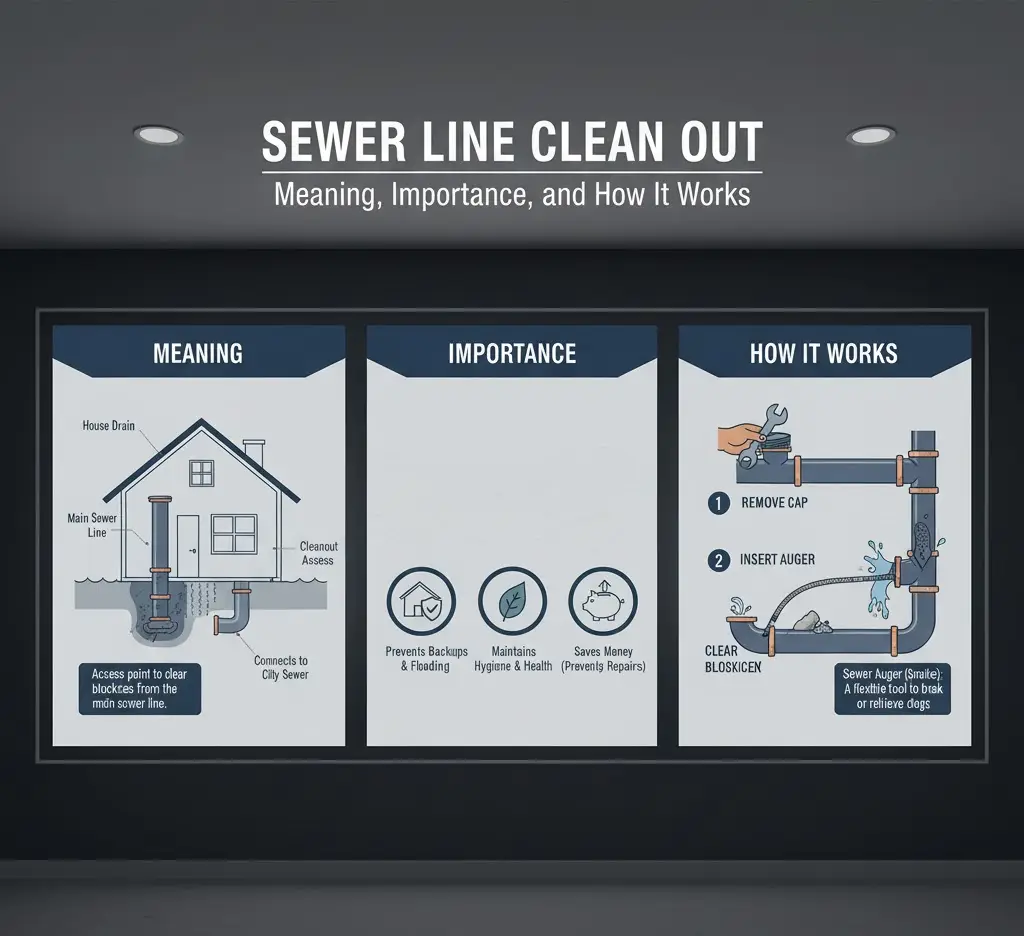Clean outs are plumbing features present in nearly every home. However, they are commonly overlooked, and many homeowners don’t even know they exist, especially until a blockage happens and they are in need. Learning about sewer clean outs, their purpose, and their uses can provide homeowners with valuable knowledge to help alleviate some of the stress, expense, and time with plumbing problems. The purpose of this guide is to help homeowners learn about sewer clean outs in the easiest and most straightforward way possible.
What is a sewer line clean out?
A sewer line clean out is a specialized access point on a home’s main sewer line that a plumber has to use in order to inspect the line, clean the line, or unclog the line. It typically looks like a capped, cylindrical pipe and can be found next to a home’s foundation, in the front yard, or in the basement, depending on its location.
Consider a sewer line clean out like a “door” into a sewer system. It allows plumbing professionals to skip the costly and time-consuming steps of yard excavation and pipe removal. Instead, they can use their specialized plumbing tools to reach and unclog a blockage or inspect the sewer system.
What are the Benefits of a Sewer Clean Out?
Sewer clean outs have advantages for both the owner of the house and the plumber. The reasons are:
Easy and Quick Emergency Access
Sewage floods are damaging to your property, and a plumber needs to have the utmost access to the clean out so that they can quickly and easily address the problem.
Lower costs of labor and repairs
Without a clean out, your plumber might have to remove fixtures, break concrete or excavate. When a clean out is available, the job is a lot easier and less expensive.
Prevents Larger Issues
A clean out can be used to routinely inspect your sewer and catch smaller, easier to fix issues. Examples are tree roots, excess grease, or damaged pipes.
Improves Drainage
A clean out plumbed sewer system will keep your sinks, tubs, and toilets from draining quickly. The more a clean out is used for maintenance, the more healthy the plumbing system will be.
What are Some of the Most Common Locations of the Sewer Clean Out?
Depending on your home, these are possible locations of the sewer clean-out:
-Forefront Yard of the Property Adjacent to the Home’s Foundation
-Yard Side Adjacent to Bathroom Collections Pit
-Basements in Older Homes
-Main Utility Areas Connected to the Building’s Drainage System
Usually, the plugs are black or white in color and have a width of from 3 to 6 inches, and to my experience, houses tend to have 1 or sometimes many of these plugs to provide access to the drainage system’s branch lines.
Common Signs You Need to Use the Sewer Clean Out
If your sewer line is blocked or has other problems, you may notice the following warning signs:
- Multiple drains are clogged at the same time.
- Sinks and showers are draining slowly.
- You hear gurgling or bubbling noises in the toilets.
- There is a bad sewage smell in the house or outside of it.
- Wastewater is backing up in the tubs, toilets, or basement drains.
When these problems occur, it is usually because the main sewer line has a blockage. To find and repair any damage to the main line, a cleanout is essential.
The Process of Sewer Line Clean Outs in Clog Removal
The following will illuminate how a plumber performs cleaning and repair tasks using a clean-out.
- Opening the clean-out
The plumber will unscrew the cap in order to gain access to the pipe and to its inner workings. When the cap is removed, it can cause a release of pressure, and, in some cases, that pressure release can lead to a backup.
- Insertion of the Tools
Tools used in the plumbing profession that can be inserted into a clean-out include plumbing snakes, diameters or hydro-jet systems. These tools provide plumbers with access to the clog.
- Determine the Source of the Clog
There are a number of tools a plumber can use to locate a blockage within a plumbing system that include inspecting systems with a camera to look for damage, roots, and grease accumulations.
- Line Cleaning
Water and mechanical tools are used to remove clogs, using a process of jettisoning to cleanse and operationalize the plumbing system.
- Clean and Seal
The last step in the plumbing process is to safely close the cap to stop the leaking of gas, vermin, or methane into the atmosphere.
Different Types of Sewer Clean Outs
There are primarily three categories.
- Simple Clean-out
This configuration consists of only one access point and is typically installed in the area of the sewer line that is most proximal to the exterior of the residential dwelling.
- Two-Way Clean-out
This configuration consists of one additional access point located at the system leg that is toward the public sewer system, and is designed to provide a more efficient cleaning process.
Basement Clean Out
Basement clean-out systems are standard features installed along the main waste line of your house. This features current building basement standards and typical installation for older houses in your area.
Maintenance Tips for Sewer Clean-Outs
It is important to complete regular upkeep to avoid focusing on the negative aspects of experiencing blockages and costly repairs.
- Do not flush any and all non fragmentation approved wet wipes, sanitary napkins, or other foreign items not intended to be added to the waste stream.
- Try to avoid any and all heavy grease and oil down the kitchen plumbing.
- Try to avoid tired clean outs of any type.
- Do not forget to keep clean out covers and other routing pathway features kept tightly shut.
- Make sure to cut back trees and shrubs whose roots may be attempting to get into to enter the sewer line.
If all these tasks are completed on the regular, you can rest easy that your plumbing is working and will continue to work without any issues for years to come.
Are Homeowners Allowed to Use The Clean Out?
Homeowners may be able to do basic tasks such as looking for blockages or debris and removing it from the entrance, but anything that involves using tools to access the pipes should be left to professionals as it can do serious damage to the system. Tasks such as deep cleaning or hydro jetting should not be done unless by licensed plumbers.
Benefits of Installing a Sewer Clean Out (If Your Home Doesn’t Have One)
If you have an older home and do not yet have a clean out, installing one can be a great benefit. Here are a few of them:
- Immediate response during plumbing emergencies
- Unclogging is easier and more efficient.
- Lower overall repair and maintenance costs in the long run.
- Improved diagnostics via the use of inspection cameras.
- Enhanced home valuation from a more efficient plumbing system.
The installation is quick for a licensed plumber, and will be worth it over time.
Conclusion
A clean out for a sewer line is not the most common of features, but it is more important than most people realize. It streamlines the access you and other plumbing professionals have to your home’s main sewer line, and therefore it facilitates the easier, faster and more cost-effective cleaning and repair of your plumbing system. If you often experience slow draining, backups, or clogs, you will be better off with a clean out. It is important to understand the clean out and how it contributes to the plumbing system, so that you can avoid some of the more expensive problems that can arise from a poorly functioning plumbing system.
FAQs
What does a sewer clean out do?
It provides access to the main sewer line for cleaning, unclogging or other methods of inspection.
Where is my sewer clean out located?
It is typically located outdoors or in a basement, and is placed close to the main plumbing line.
Is there a cleanout in every home?
No, older homes may not have one, but it is easy to install.
How often should I clean my sewer line?
Once a year is ideal, but especially if you have trees near your sewer line.
Can I open the cleanout myself?
You can open it for a basic inspection, but any deep cleaning should be left to a professional.
Also Read: The Ultimate Guide to Buying the Perfect Cup and Saucer


